As we leave the most populous metropolitan area in the world, I would like to take this chance to process my impressions. These are not highly organized and are certainly not researched. These are just observations – some informed by our excellent guide and friend Altus and others more off-the-cuff.
Observation #1: Japan is a bit like Victorian England
Highly developed societies often create highly refined, and even arcane, traditions and customs. In the West, I tend to think of England in the early 20th century. Anyone that has watched an episode of Downton Abbey or read a Jane Austin book will be familiar with the elaborate and even burdensome nature of the English upper class.  A typical day might include 4 meals (breakfast, lunch, high tea and dinner), each requiring its own attire. If you toss skeet shooting or a fox hunt, you could look forward to wearing 5 different outfits before you don your pajamas.
A typical day might include 4 meals (breakfast, lunch, high tea and dinner), each requiring its own attire. If you toss skeet shooting or a fox hunt, you could look forward to wearing 5 different outfits before you don your pajamas.
A formal English meal was a maze of forks and spoons and plates and customs. Your seat corresponded with your station and you entered the room accordingly. At the meal, certain topics are OK, others are not. How do you know? You are born into the upper class and learn through excruciating observation of your high-born parents.
At some level, customs and manners become less about courtesy and more about membership.
Japan is similarly awash in traditions, customs, and taboos. Some make perfect sense, even if unfamiliar. For instance, I can understand removing the shoes that walked the dirty streets before walking in the home. Other customs are just bizarre. For example, you do NOT put your chopsticks into your rice and leave them there standing up. That means that someone has died. That is not quite obvious, is it? But it is certainly true. But when Altus saw that one of us had done this, he literally gasped and implored us to rectify the situation immediately. [I have recreated the faux pas in this photo - sorry Altus! The second picture is actually just two toothpicks in 4-6 pieces of rice. I assume that this might portent the passing of a small bird.]
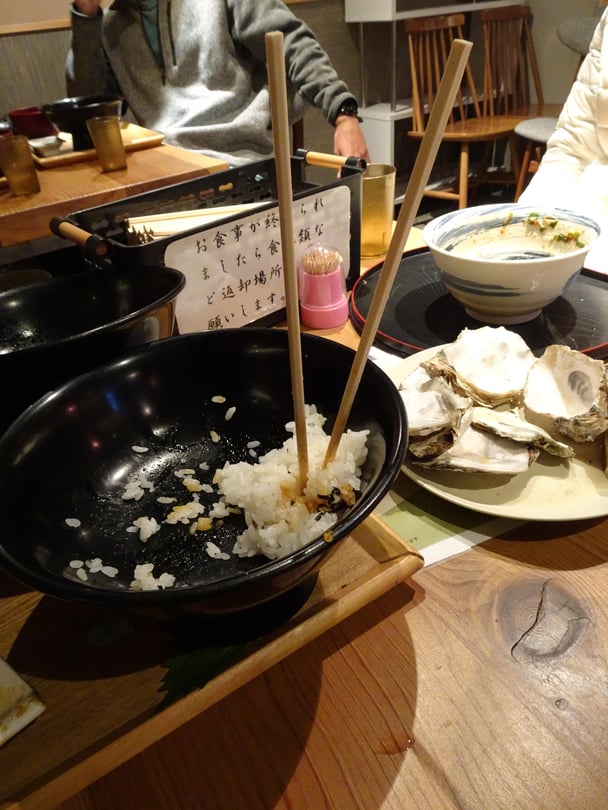
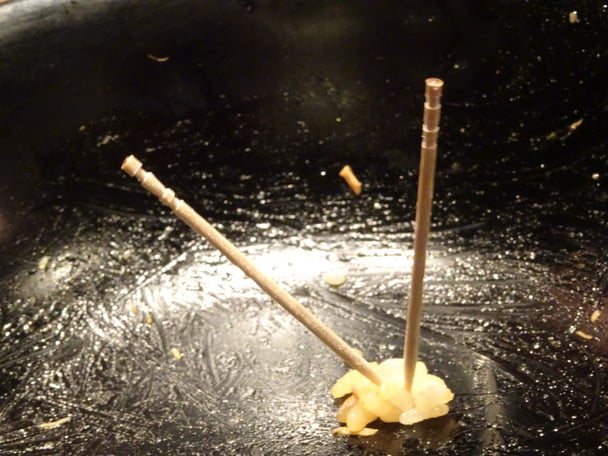 Even with the earnest and enthusiastic help of Altus, we managed to prove ourselves to be consistent heathens. We were good about some of the traditions and really poor about others.
Even with the earnest and enthusiastic help of Altus, we managed to prove ourselves to be consistent heathens. We were good about some of the traditions and really poor about others.
What we did well:
- With the exception of the chopsticks/rice death omen, we “respected the hashi (chopsticks)”. We used them properly and did not mix personal hashi with serving hashi. We placed them properly on top of empty rice bowls when finished after putting them back into the paper holders. Another exception is the fact that Virginia is left handed – something that parents in Japan (and China) strive to avoid.
- We knew when and how to bow. With people and at temples, we were consistent about bowing to others. We can bow correctly when going through gates and when inside a shrine.
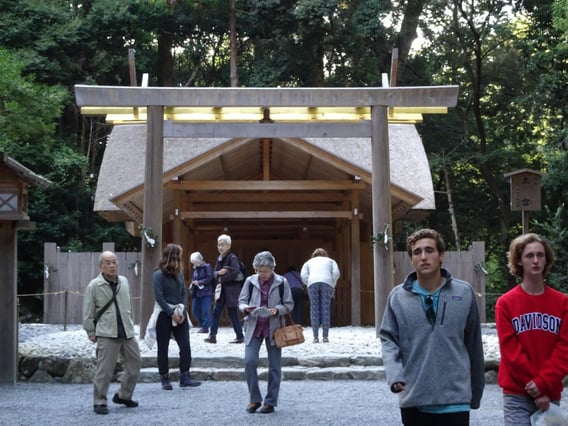
- We also know how to wash before entering a shrine (left hand, right hand, left hand with water into mouth, left hand again).
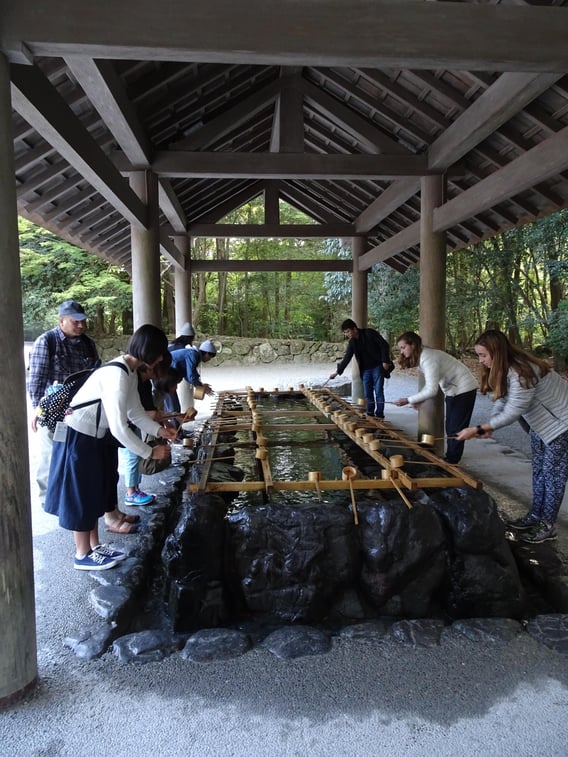
- We mastered some of the basic language of courtesy – hello, thank you, goodbye.
- We learned the proper way to serve sake. This includes not serving yourself and always refilling the cup of those around you, pouring in a particular way, holding the cup in a particular way (with your second hand underneath the cup like you are creating a pedestal), miniature bows, never putting the cup down without taking a sip and always toasting “Kompai” when a new bottle is poured.
- Not stepping on thresholds. You step over the threshold and not on them.
- We did not jaywalk. In New York, I earned a merit badge in jaywalking. I have walked across highways in China and in South Africa. But in Japan, we wait for the lights.
- We are seriously accomplished noodle slurpers. Name your noodle (Ramen, Udon, Soba), we can slurp like champs.
Areas where we struggled:
- I just could not get the hang of taking off the shoes, especially in our tiny 250 square foot apartment that felt more like foyer than a home. My absent-mindedness provided great amusement to our children, who took turns reminding me in ways that suggested I was slowly fading into dementia. Why they take joy in my inability to take off my shoes is slightly lost on me, but who am I do deny them joy?
- We failed to always remember the right greeting/departing words. One of the traditions that consistently amused me is the tendency for all employees in a service establishment (like a noodle shop or a barber shop) to simultaneously call out greetings or goodbyes as customers entered or left. Whenever it happened, I could not help but think of the TV show “Cheers”, where everyone would call out “Norm!” whenever the character of that name entered the bar.
- The Japanese walk and drive on the left. When we walk the street or in the subway, we tend to drift to the right. This is not a great habit in places like the subway. [Note: the “walk on the left rule” seemed to be absolute, except when it is not. Occasionally, a stairwell would switch this rule with no discernable reason for doing so. But, to be clear, there is always a correct side to walk on, but you need to stay aware to figure out what side it is.]
- We might have respected the hashi, but Susie tended to disrespect the rice. She poured soy sauce into her rice bowl. I know. Horrific. I choose to love her despite this blight.
- We drank and walked at the same time. No, not beer or wine. We drank water as we took some of our long walks. This is not OK. I have no idea why. The proliferation of the Starbucks take-away cup might bring this tradition to its knees, as we noticed several younger Japanese walking with their coffee cups. Though I am not sure I actually saw anyone drinking from the cups. Perhaps most people continue to observe this custom.
- I assume that there are about 1000 subtleties that we simply were oblivious of. Occasionally, we would see a look of disappointment from a local, but happily they were too polite to explain exactly what we had done.
Observation #2: The Japanese are very healthy, except when they are not.
The Japanese diet is quite healthy, heavy on vegetables and fish and very light on red meat and carbohydrates. Their portions are smaller. Most of the food is incredibly fresh. Even McDonalds has elaborate signs that document the source and processing of all their offerings.
The people we saw and met were fit and rarely overweight. We spent time with a woman in her 50’s who runs a noodle shop. After serving us, she hopped on a bike and left to deliver noodles to local businesses. 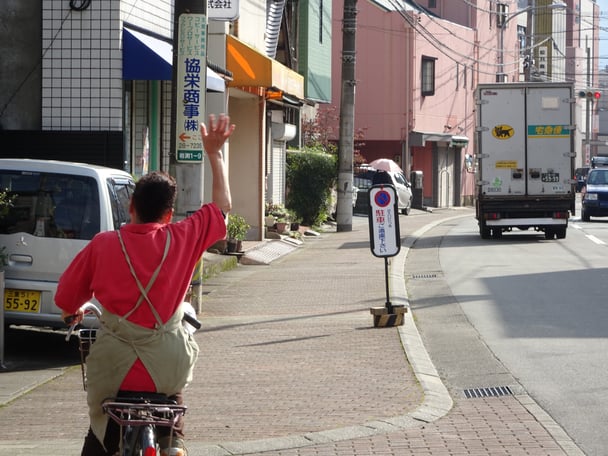
Many people walk around with surgical masks to avoid getting germs. I also saw masks in Beijing, but these are to deal with the huge air pollution issues. Here, the air is clear and the enemy is germs.
This brings me to the ultimate expression of Japanese germ phobia: their elaborate toilets. In the US, we live in a world were the only connection to a toilet is plumbing – some pipe brings water in and another conveys waste away. Simple and (I would have thought) sufficient. This photo is a run-of-the-mill model. We have not had the nerve to bring a camera into a restroom with a high-end version.
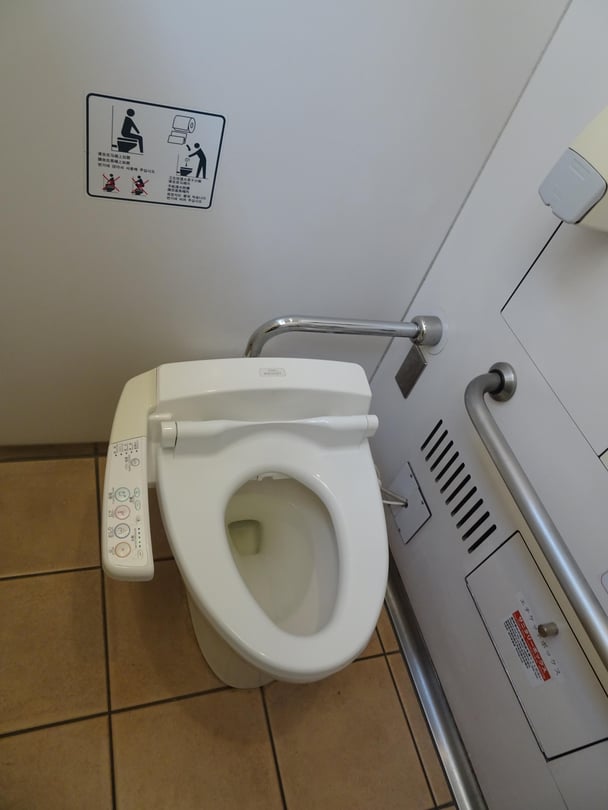
An experience with a top-notch toilet here will introduce you to a myriad of options that are sometimes nice, occasionally amusing and always confusing (as many of them are not translated into English). In even the most pedestrian establishments, the toilets offer a few more options than I actually require.
With the most elaborate toilets, your options can include
- Spray deodorant
- Disinfecting UV lights
- Seat warmers
- Automatic lifting and dropping of the seat,
- A mister
- A bidet
- And (always a crowd favorite) sound effects and musical options to mask the sounds of your private moments.
If, however, you do not speak Japanese, I would advise experimenting with care. Two days ago, Susie emerged from a bathroom thoroughly amused. Apparently Virginia chose to experiment with the technology; after all, she is perhaps the most tech-savvy of our family. While attempting to choose a sound selection, let out a surprised whoop when she turned on the high-pressure bidet instead.
Remember that I said that the Japanese are healthy except when they are not? The odd exception to the healthy lifestyle in Japan is their penchant for smoking.
You can still smoke inside and in restaurants. A Burger King had a sign outside that said “capacity of 64, 17 smoking, 47 non-smoking”. We had several meals where we needed to find a place separate from the smokers.
It seems odd to me that different cultures will embrace certain health rules and happily ignore others. In the US, we generally acknowledge the dangers of smoking, but we have a weakness for refined carbohydrates. Here in the land of exercise and low-fat protein, they channel their inner Marlboro Man.
One of my favorite pictures shows this health dichotomy: this young man was wearing his surgical mask as he came to the small smoking room for a quick puff. I am sorry that this photo fails to convey the comic elements of the situation. The "smoking room" that he will soon enter had roughly 15 people in a space the size of a small kitchen. He has pulled down his mask while pulling out his pack of cigarettes. I believe this is first class irony.
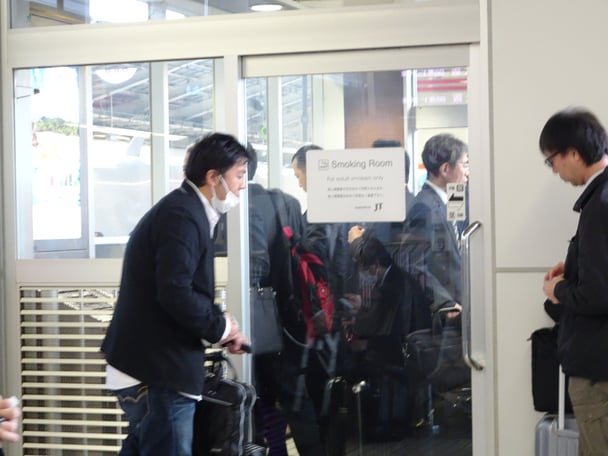
We humans are an interesting lot.
Tomorrow, I will share some final observations.
Steve Sir


